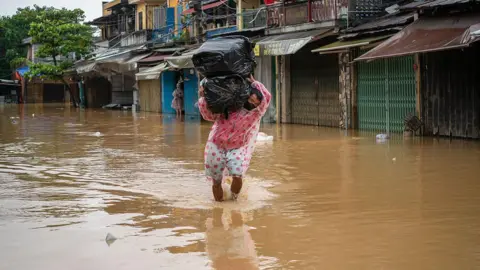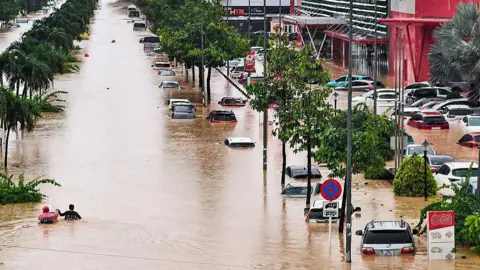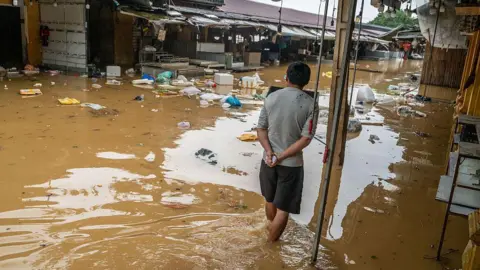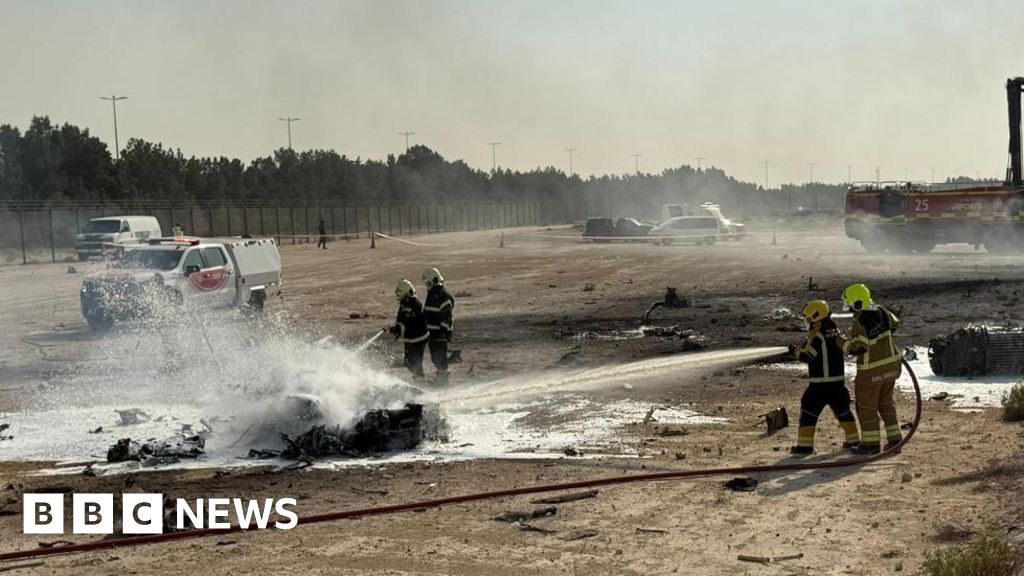Relentless rains and floods have killed at least 41 people in central Vietnam since the weekend, while a search continues for nine still missing, state media reports.
The deluge has submerged more than 52,000 homes and left half a million households and businesses without power, according to reports. Tens of thousands of residents have been evacuated from the flood-affected regions.
Rainfall has exceeded 1.5m (5ft) in several areas over the past three days, even rising beyond the 1993 flood peak of 5.2m in some parts.
Extreme weather has battered Vietnam in recent months. Two typhoons, Kalmaegi and Bualoi, left a trail of death and destruction within weeks of each other.
 Getty Images
Getty ImagesNatural disasters in Vietnam have wreaked damage amounting to $2bn (£1.5bn) between January and October this year, according to government estimates.
The areas worst-hit by the latest rainfall include the coastal cities of Hoi An and Nha Trang, as well as a key coffee production belt in the central highlands – where farmers are already reeling from a stalled harvest because of the earlier storms.
In the province of Dak Lak, the country’s biggest coffee growing region, tens of thousands of homes were submerged, according to state news outlet Tuoi Tre.
Vietnam is one of the largest exporters of robusta, the bitter tasting bean used in instant coffee and some espresso blends.
Weather conditions in the region are set to last until at least Sunday, according to authorities. Military troops and police officers have been deployed to set up emergency shelters and to relocate people to safety.
The province has declared a state of emergency after landslides damaged major roads and highways.
Traffic was completely halted after part of the Mimosa Pass, a key entry route into the popular tourist city of Da Lat, collapsed into a ravine, while a bus narrowly avoided falling into the gap, news agency AFP reported.
 Getty Images
Getty ImagesPhotographs published by local media show people stranded on roofs as floodwaters fill their homes, while a video circulating online shows a suspension bridge in Lam Dong province getting torn off its anchors.
A restaurant owner in Nha Trang told AFP that his shops were submerged by about a metre of water.
“I am worried about our furniture in my restaurants and shops, but of course I cannot do anything now,” said Bui Quoc Vinh.
“I don’t think the water is going to recede soon, as the rain has not stopped.”
 Getty Images
Getty ImagesEarlier in November, Typhoon Kalmaegi killed at least five people in Vietnam’s central coast, uprooting trees, tearing off roofs and smashing windows. Many in Dak Lak province said their homes had collapsed or flooded.
The same typhoon had killed 188 people in the Filipino island of Cebu, before making its way to Vietnam.
And in September, at least 11 people died after Typhoon Bualoi hit the centre and north of Vietnam. The typhoon had packed winds of 117km/h (73mph) when it made landfall in central Vietnam.
Experts say climate change has exacerbated extreme weather, with typhoons becoming stronger and more frequent.



